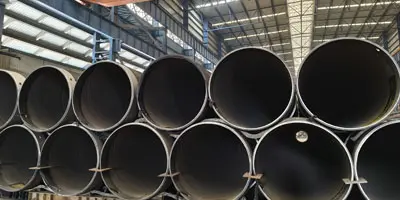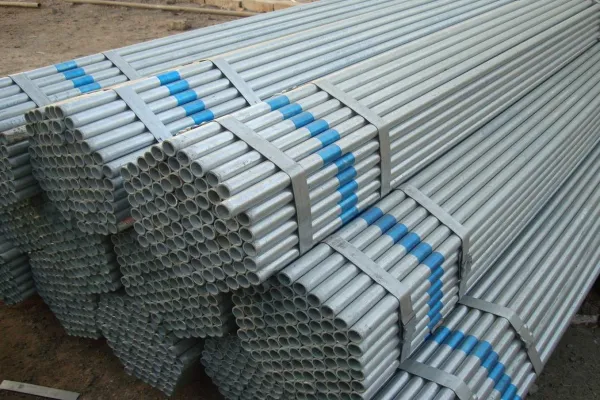Galvanized steel pipe is a kind of pipe material widely used in construction, machinery, chemical industry and other fields. Its manufacturing process and production method play a vital role in the quality and performance of the product. The surface of the galvanized pipe is coated with a layer of zinc, which can effectively protect the steel from corrosion. It is usually used in outdoor buildings, such as fences and handrails, or some indoor pipes. In practical applications, understanding the advantages and disadvantages of galvanized steel pipes can help us choose the right materials according to needs, thereby improving the quality and efficiency of the project. Galvanized steel pipes have both unique advantages and certain disadvantages.
Manufacturing process and production method of galvanized steel pipes
The manufacturing process of galvanized steel pipes mainly includes hot-dip galvanizing and electro-galvanizing. Hot-dip galvanizing is to immerse the steel pipe in molten zinc liquid so that a layer of zinc is attached to the surface of the steel pipe to achieve the purpose of corrosion prevention. Electro-galvanizing is to deposit a layer of zinc on the surface of the steel pipe by electrolysis. Both methods have their own advantages and disadvantages. Hot-dip galvanizing has a thick galvanized layer and better anti-corrosion performance, but the cost is higher; electro-galvanizing has a lower cost, but the galvanized layer is thinner and the anti-corrosion performance is relatively poor.
In terms of production methods, galvanized steel pipes are mainly produced using continuous galvanizing production lines. The production line includes three main links: pretreatment, galvanizing and post-treatment. Pretreatment mainly involves cleaning, rust removal, passivation and other treatments on the steel pipe to ensure the cleanliness and activity of the steel pipe surface; the galvanizing link is to galvanize the pretreated steel pipe to form a zinc layer; post-treatment mainly involves cooling, passivation, oiling and other treatments on the galvanized steel pipe to improve the corrosion resistance and appearance quality of the product.
Advantages and Disadvantages of Galvanized Pipes
Advantages of Galvanized Steel Pipes
1. Good Corrosion Resistance
Galvanizing is one of the most durable coatings in metal finishes. Under normal conditions, the service life of industrial galvanized steel can exceed 50 years. Similarly, galvanized steel can be used for more than 20 years even in frequent contact with water. In fact, if a coating with an average thickness of 85 microns is used, the service life of the steel structure can reach 100 years.
The coating thickness produced by this process helps the metal meet the corrosion resistance requirements in various situations. In most cases, basically no maintenance is required, which improves the reliability of the product.
2. Strong weather resistance
Since the zinc layer of galvanized steel pipe has strong oxidation resistance, it can resist wind, sun and other harsh weather conditions, and is especially suitable for buildings, fences, transportation facilities and other occasions that are exposed to the outdoors for a long time. As a sacrificial anode, the zinc layer preferentially reacts with oxygen and water (forming a dense ZnO/ZnCO₃ protective film) to delay the corrosion of the steel pipe. It is suitable for humid, weak acid/alkali environments (such as outdoor and underground buried pipelines), and its service life is 3~5 times longer than that of ordinary carbon steel pipes.
3. Low maintenance cost
During use, galvanized steel pipes do not require frequent maintenance and replacement, especially in places that are not easily accessible, such as underground pipelines, outdoor facilities, etc. Compared with other materials, galvanized steel pipes can effectively reduce maintenance costs in long-term use.
4. Mechanical properties
Carbon steel galvanized pipes have good mechanical properties and retain the high strength (compression and impact resistance), toughness and ductility of carbon steel. This enables carbon steel galvanized pipes to withstand greater pressure and impact, and is suitable for pressure-bearing pipes (such as fire water supply).
5. Improve structural stability
Galvanized steel pipes have high strength and rigidity, which can provide solid structural support for buildings. Especially in environments with greater pressure, its pressure resistance is very superior. The iron element in steel and iron alloys is prone to rust. However, the combination of zinc and iron elements helps to form a protective layer between the metal and moisture or oxygen. The metallurgical bond formed provides safe and comprehensive protection from the beginning. Even grooves and sharp corners can be protected by this coating from damage.
However, galvanized pipes also have some disadvantages:
1. Limited corrosion resistance: Although the galvanized layer can improve the corrosion resistance of steel pipes, in some special environments, such as high temperature, high humidity, strong acid and alkali, the galvanized layer may be destroyed, causing corrosion of the steel pipe.
2. Environmental protection issues: The waste slag and wastewater generated during the galvanizing process cause certain pollution to the environment, and environmental protection measures need to be strengthened.
3. Pipeline connection problems: The connection methods of galvanized pipes are mainly threaded or welded, and water leakage and seepage are prone to occur at the connection points, so sealing measures need to be strengthened.
4. Environmental restrictions: Although galvanized steel pipes have good anti-corrosion properties, in some special environments, such as places with high pH, galvanized steel pipes may not provide sufficient protection, resulting in failure of the zinc layer and rust of the steel pipe. Therefore, for such extreme environments, it is necessary to consider using other pipeline materials with stronger corrosion resistance.
In summary, as an important pipeline material, galvanized steel pipes have certain characteristics and requirements in terms of manufacturing process and production methods. In actual use, we need to fully understand its advantages and disadvantages, and reasonably select and use them to improve the quality and benefits of the project. At the same time, it is also necessary to strengthen environmental protection measures to reduce the impact on the environment.






 English
English Español
Español بالعربية
بالعربية











 Phone :
Phone :  Whatsapp :
Whatsapp :  Email :
Email : 


